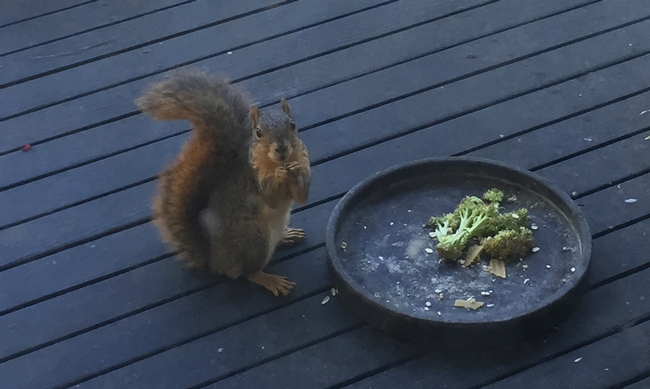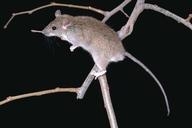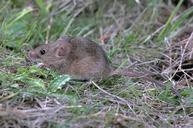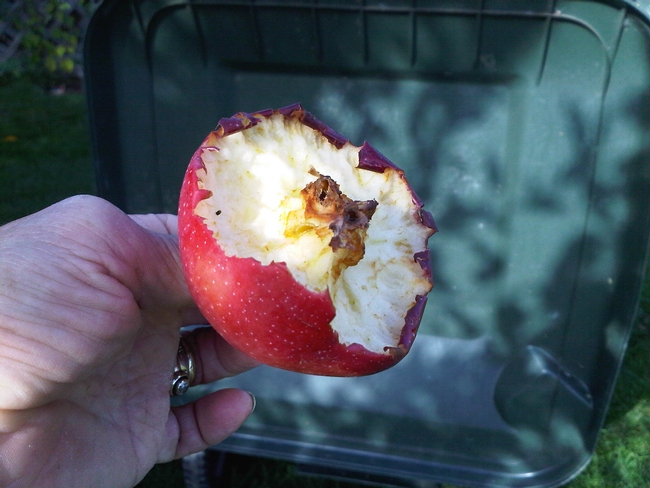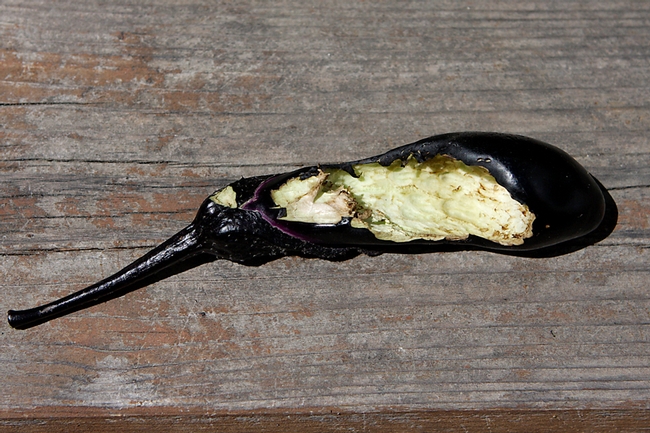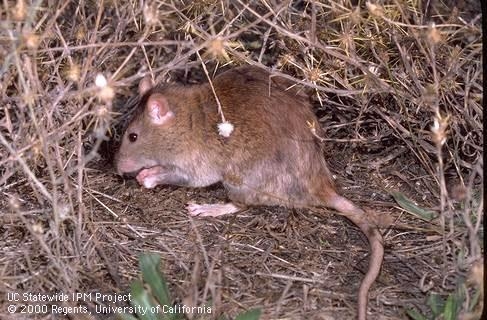Posts Tagged: rats
Don’t feed wild animals, says UC ANR pest expert
Did you know that it is illegal to feed wildlife? As tempting as it is to put out bread crumbs for birds or deer chow for Bambi, there are downsides to feeding wild animals, says a UC Agriculture and Natural Resources expert in human-wildlife conflict resolution.
California law states: “Except as otherwise authorized in these regulations or in the Fish and Game Code, no person shall harass, herd or drive any game or nongame bird or mammal or fur-bearing mammal. For the purposes of this section, harass is defined as an intentional act that disrupts an animal's normal behavior patterns, which includes but is not limited to, breeding, feeding or sheltering. This section does not apply to a landowner or tenant who drives or herds birds or mammals for the purpose of preventing damage to private or public property, including aquaculture and agriculture crops.”
Feeding wild animals may help non-native, invasive, nuisance and feral animals survive, says Niamh Quinn, UC ANR Cooperative Extension advisor in San Diego and Los Angeles counties.
“Many of these species have public health risks associated with them, which can cause serious illness in humans,” Quinn said. “Rats and squirrels carry fleas that transmit plague and feral cats also carry fleas that carry typhus. Both of these diseases can be transmitted to people and cause serious illness, or even death.”
During the summer of 2015, two tourists at Yosemite National Park contracted plague, but humans are not the only ones at risk from disease. Wildlife can also become more exposed to disease as a result of people feeding them.
The Pacific Flyway is a major north-south flyway for migratory birds in America, extending from Alaska to Patagonia. As part of the Pacific Flyway, California is a temporary home for many species of birds. Due to people feeding them, some of these birds no longer naturally migrate.
“Unfortunately, when we feed birds at parks with lakes and ponds, we are encouraging these unnatural situations and not helping the health of these bird populations,” Quinn said. “This can cause unnatural numbers of water fowl to congregate in ponds, rivers and lakes and creates perfect conditions for avian botulism and cholera to take hold. Bird die-offs can occur naturally in wilderness areas and are prominent in drought conditions due to low water resources.
Sustaining nonnative and feral animals can also have negative impacts on native wildlife, she said.
“For example, the eastern fox squirrel, which has now been released in many cities in the state, is competing with the native western gray squirrel,” said Quinn. “Sustaining the nonnative and invasive eastern fox squirrel could further aid in its distribution in the state, which would spell disaster for the native gray squirrel.”
Leaving nuts and seeds out for squirrels can also encourage other nonnative wildlife like roof rats and house mice.
“Not only do these species have public health issues associated with them, they also compete with native wildlife,” Quinn said. “They prey on bird eggs and can compete with native rodents for food resources.”
Indirect feeding of wildlife can also lead to serious conflicts between people and wildlife, Quinn warned.
“Bears that become accustomed to human food often have to be trapped and re-released and some are even euthanized,” Quinn said. “Coyotes are now common-place in some of our cities in California. Relying on human food could cause habituation of these wild animals and cause conflicts to rise. It is important that we cover our trash cans and make sure that we keep wildlife out of them.”
The California Department of Fish and Wildlife has an initiative called “Keep Me Wild” with the slogan “Wild animals don't need your handouts. They need your respect.” Quinn urges people to consider the long-term welfare of wildlife the next time they are tempted to feed wild animals.
For more information about managing pests around homes, visit the UC ANR Statewide Integrated Pest Management Program website: http://www.ipm.ucanr.edu/PMG/menu.homegarden.html.
Roof Rats
When my friend Donna told me that roof rats were eating all her persimmons, I was incredulous. Roof rats? And what a mess they made, too! Eating half the fruit (the half you didn’t see), so that when you reached to pick it, your unsuspecting fingers sank into squishy soft, wet flesh, rather than the firm cool surface you had been expecting. She eventually had her husband put out large snap traps for them, traps that resembled oversize baited mousetraps, and her problem ended for this season.
So it’s my turn now. While cleaning up the windfalls under my unknown species apple tree (perhaps a variety of Red Delicious) I came upon what initially looked like edible windfalls which I collect and use, and some lovely firm fruit still hanging. But only half of the apple was there – the rest had been eaten on the tree. Oh dear. Roof rats…so that’s what my dog was barking at some nights ago. She was actually trying to climb that apple tree. At this point I’m reluctant to put out traps. I may have to, but I’m hoping that my dog’s presence will deter future foraging. We’ll see about that!
For more information about dealing with roof rats, see this link http://ipm.ucdavis.edu/PMG/PESTNOTES/pn74106.html.
OH, rats!
When I was a kid, I had a pet rat. The offspring of “Rat Olympics” medal winning parents, she was friendly and athletic. A smart rat, I trained her to perform several tricks. She was a domesticated rat and my pet. The wild rats that have been using our vegetable garden as their cafeteria, are pests.
There are many public health issues associated with wild rodents and any pest problem is best dealt with early, before it gets out of control. The two most common rat species in California are the Norway rat (Rattus norvegicus) and the roof rat (R. rattus). Sanitation, rat proofing, and population control are the three main aspects of managing a rat problem.
The first sign of my rat problem was early in spring: vanishing bok choy (Brassica rapa chinensis). The outer leaves of the young leafy clusters were disappearing one by one over the course of a few nights. The amount of damage could not have been caused by insects and no evidence of slugs or snails was visible. Since they are active at night, I suspected rats. I constructed 24-inch tall cylinders of hardware cloth to protect the plants. After a few nights of experimenting with methods for securing the cylinders to the ground, the leaves remained undamaged. Hungry rats will find a way around obstacles, so I buried the hardware cloth about an inch deep and used garden staples to hold it in place. The bok choy was now rat proofed.
There are many methods of population control of rats. I feel badly about it, but let’s be honest, we are talking about killing rats. Using live traps is an option, but Norway and black rats are not native to California and releasing them in the wild could be harmful to the native plants and animals.
Things to consider when choosing a control method:
Rodent baits contain poisons that are also toxic to pets, wildlife, and humans. It may take several days for the poison to work allowing the rat (or mouse) the opportunity to find an inconvenient place to die like inside a wall or under a deck. The carcass may still contain active poison that could be harmful to cats, dogs, or wildlife that might consume it.
Glue or sticky traps are usually ineffective and rats can drag them around as they struggle to escape. Glue traps can be dangerous for wildlife such as birds and reptiles, and small mammals like kittens.
Trapping with a spring type trap is recommended by UC IPM as the most effective. It may be labor intensive, but it works. Over the summer, we controlled more than twenty rats in our garden. We religiously set the traps in the evening and unset any unused traps in the morning. Why not leave traps out all the time? Dogs, cats, and wild birds looking for food could be injured by the traps, and that is definitely not the intention.
For more information on managing rats, including trap setting strategies, visit the UC IPM website for Pest Note number 74106 http://www.ipm.ucdavis.edu/PMG/PESTNOTES/pn74106.html


